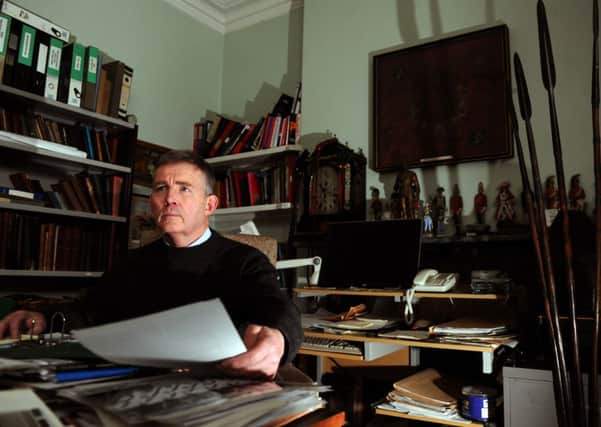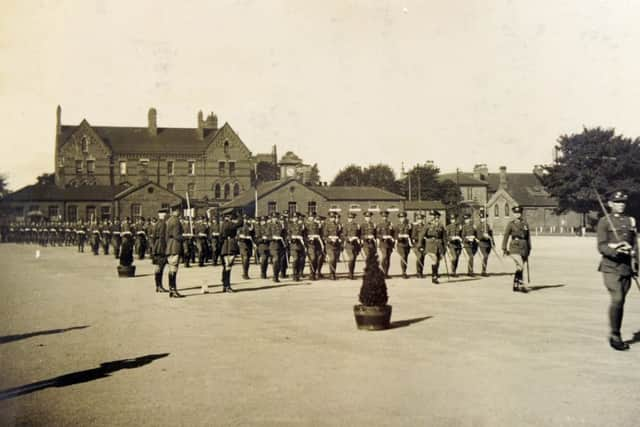Joining forces to tell York’s story


Shortly after 6.30am on a summer Sunday morning just outside a Belgian village called Casteau near Mons, Corporal Edward Thomas leapt from his horse, seized his rifle and shot a German cavalryman out of the saddle.
The date was August 22, 1914. Corporal Thomas, a drummer in C Squadron of the 4th Irish Dragoon Guards, had stopped to water his horse, along with the rest of his detachment, at a crossroads. A local farm worker approached and tipped them off that German lancers were heading their way.
Advertisement
Hide AdAdvertisement
Hide AdA trap was set but the Germans smelt a rat and retreated. The dragoons chased them through Casteau’s streets and dismounted with their rifles when the enemy horsemen turned to fight on open ground. After Corporal Thomas had brought one down, the officer leading the pursuit, Captain CB Hornby, killed others with his sword.


British casualties amounted to one horse, shot through the stomach, which had to be destroyed. The fight was all over in about three minutes.
Hardly worth a mention when weighed in the scale of industrial killing in what was to follow, except that Corporal Thomas’s shots were the first fired by the British Army in the Great War.
Jump ahead to winter 1918. At 10.40 on the morning of November 11, Brigadier Bernard Freyburg VC of the 7th Dragoon Guards was ordered to ride to take the Belgian village of Lessines and seize a key road bridge over the River Dendre. Ten miles inside enemy territory, it had been primed for demolition.
Advertisement
Hide AdAdvertisement
Hide AdTen dragoons charged the bridge seconds before the clock struck eleven marking the start of the Armistice, securing the river crossing. This gallop by Freyburg, a soldier later to become one of Churchill’s favourite generals in the Second World War, was the last British action to be ordered at the conclusion of the First.
These minor 1914 and 1918 actions are bookends to the four years of unprecedented bloodletting in between and they are central to a military story about to be re-told in York. In the museum of the Royal Dragoon Guards are photos of their men, Corporal Thomas and Captain Hornby, along with Hornby’s sword. There’s also a striking action print of Freyburg’s men capturing the bridge at Lessines.
Their regimental headquarters and their museum have been in York since 1992. But the dragoons’ connection with the city, one way and another, goes back some 300 years.
In 1829 they raced from the cavalry barracks on Fulford Road to the Minster to help put out the fire started by arsonist Jonathan Martin.
Advertisement
Hide AdAdvertisement
Hide AdToday their regimental home in Tower Street is shared with the Yorkshire Regiment who also have their regimental HQ and museum here.
As a shop window for the army and its exploits it’s a perfect location, in the shadow of Cliffords Tower and facing the Castle Museum.
But over the years the two linked museums have rather fallen short.
Compared with what else is on offer in York’s museums quarter, they seemed stuck in the past. The Jorvik Centre just around the corner redefined the scope and shape of what an historical visitor attraction could be decades ago. And where they led, other York museums followed and picked up on the interactive, the innovatory, the tactile and the eye-catching as a means of bringing history to life.
Advertisement
Hide AdAdvertisement
Hide AdThe respective regimental secretaries, Major Graeme Green of the of the Dragoons and Lt Colonel David O’Kelly of the Yorkshire Regiment began discussions about how to improve their offering in January 2011.
Now with the help of £1m of Lottery cash, the museums are to become one and will tell the story of the Yorkshire soldier from the beginning.
Re-named the York Army Museum, it will re-open in August on the centenary of the start of the Great War. On August 15 there will be a York Minster Great War centenary service and a Freedom Parade – the dragoons received the freedom of the city in 1999.
“The museum started in 1984,” says David O’Kelly. “It looked tired and we felt it needed a lift. There are 37 other visitor attractions in York and we had been left behind. It was disquieting to find that even York residents didn’t know there was a museum. It was a well-kept secret.”
Advertisement
Hide AdAdvertisement
Hide AdHis counterpart Graeme Green adds, “One of the reasons why the Ministry of Defence invests in the museum is education,” and this was one of the main themes driving the push for change.
They were aware how wide the gap can be between what people are assumed to know and how sketchy their grasp of history really is.
They tell the tale of a youngish couple who came to visit the museum with two kids in tow. Standing in front of one of the exhibits – a book open at the title page with a full-page photo of the author opposite – one parent asked the other, “Who’s that?” The other shrugged. “Dunno”. The book was Mein Kampf and the man in the big photo was Adolf Hitler.
“But let’s give them full marks for coming in and paying their money to help their children learn something,” says the museum’s curator Captain Alan Henshall.
Advertisement
Hide AdAdvertisement
Hide AdHe is also the assistant regimental secretary and he sits in a fascinating archive-cum-office stuffed with intriguing things, odds and ends, books and photos recalling antique days in distant, dusty corners of Empire where the Union Flag was still flying.
In one corner spears are stacked against the wall. Are they genuine? “Oh yes, they were from Egypt.” Beside them is an ornate grandfather clock, no longer working, donated by the Lord Mayor of York in 1881 to the dragoons, thanking them for their contribution to the city.
The objects here seem more alive and thought-provoking than they do downstairs, inert behind glass in their display cases.
“It’s not about things any more. It’s about people,” says Green, “who beat the drum, rode the horse, shot the gun.”
Advertisement
Hide AdAdvertisement
Hide AdThe new buzz phrase in this line of work is “community engagement” and the plan is to take things out of the collections and into the community to tell the story of the individuals who used them and to prompt memories.
The regiments wore different uniforms but there’s a common thread. In most theatres of conflict both were usually at the pointy end of contact with the enemy. The value of small things that can personalise the big story was the broad message they took from Allan Carswell, curator of the National War Museum of Scotland. As the consultant for the York makeover, Carswell defined three broad categories of visitor – the “deep-sea diver”, the “swimmer”, and the “paddler”. Each brings with them different levels of knowledge and enthusiasm to their museum visit and all have to be catered for if the Army are to tell a joined-up story effectively.
“The things in the collections are the catalysts for our ability to interact and we are changing the focus from chronology to themes,” says Green. Digitising the regiments’ records is being undertaken by a company of volunteers who will also be the ones to take artefacts into the community. “There’s greater interest in the past these days and people wonder what their parents did when they served in the armed forces,” says Green. “Archive research has also grown enormously through television programmes like Who Do You Think You Are?” With this in mind the new museum will have experts on hand to signpost how to do military research.
On the advice of Carswell, the new museum will be divided into four zones with a full-size galloping cavalryman as the centrepiece. The British cavalry lost their horses in 1938 when they became mechanised. But there is a lot to explore from the mounted days, including what happened on the day of the most famous cavalry charge of all time.
Advertisement
Hide AdAdvertisement
Hide AdIn the Crimea in 1854, before the Light Brigade launched their doomed afternoon attempt at Balaclava to take the wrong Russian guns, the Heavy Brigade had had a much better morning. You can learn about the part played in that action by the 5th Dragoon Guards’ commander, 55 year-old Brigadier James Yorke Scarlett.
Serious military types in search of more recondite information – such as the practical uses of a sabretache – will find the answers here.
The exhibition work is now in full swing at the contractors, Studio MB in Edinburgh. One zone will be laid out like an officers’ mess with the place mats being interactive tablet-type devices. This can be adapted as a classroom or for corporate use in the evenings. “It will be a one-stop shop to learn about the Army, the story of the individual with the helmet off,” says Green.
These are straitened times for British Army budgets, even the Americans have expressed alarm about the scale of the recent cuts.
Advertisement
Hide AdAdvertisement
Hide AdMuseums might be thought to be at the back of the queue when it comes to cash for the military, but the MoD has given a written assurance that if they do have to sell-up here they will provide equivalent accommodation for the museum.
Given the unique York location, it’s hard to see how that would be practical.
To view the Yorkshire Post’s First World War centenary coverage go to www.yorkshirepost.co.uk. You can also follow us on Twitter via #YorksWW1